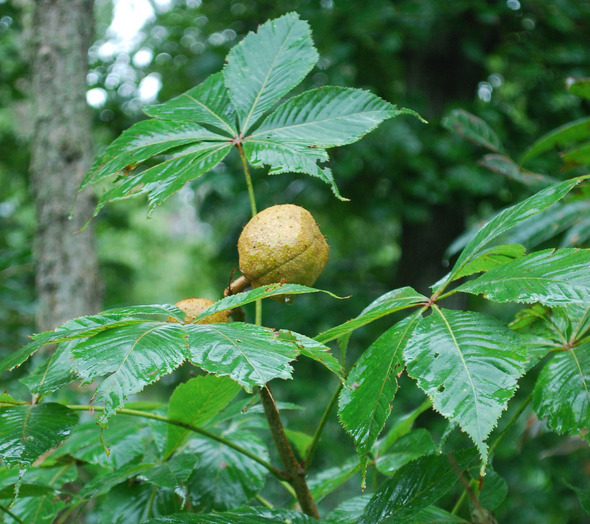This native plant is a buckeye even a U-M fan can embrace

A small American Buckeye tree (Aesculus glabra) soaks in the rain along a trail at the Matthaei Botanical Gardens.
Rick Meader|Contributor
This is it, rivalry week for the University of Michigan, the week when the team from the state to our south comes up to pollute the pristine atmosphere of our fair town for a football game. Normally, the only buckeye that I can honestly say I like is the delicious treat my sister-in-law makes for the holidays.
On a recent walk in the Matthaei Botanical Gardens, though, I was reminded that the actual buckeye, the tree whose good name was besmirched by a certain university, is actually a pretty nice tree, and one I could hug without shame. So, in honor of this special week, let's learn a bit about the American buckeye (or, apparently, the fetid buckeye — yuk, yuk), also known as Aesculus glabra.
American buckeye is a medium-sized deciduous tree native to most of the center of North America and Canada. In Michigan, it mostly occurs in the lower half of the Lower Peninsula.
It grows to about 50-75 feet high and about 30 feet wide in open, sunny settings, but may grow to only half that height in shadier settings where it is an understory tree. It has oppositely arranged palmate compound leaves (the five to seven leaflets are arranged around a center). In settings where the tree gets full sun, the leaves may become splotchy with leaf scorch by mid-summer, so it might be better to plant it in at least a partially-shaded setting. In the fall, these leaves turn bright orange and red.
As you might expect, the State of Ohio DNR has a nice account of its biological characteristics and planting information on their website, but the national register of big trees lists the largest as existing in DuPage, Ill.
It grows in rich, deep, moist well-drained soils and prefers full sun. It is a slow-growing tree that would not be a good street tree, as it is intolerant of urban conditions (compacted soils, salt, etc.) but could be a nice yard tree if you don't mind the nuts.
Some wildlife makes use of this tree for their survival. It is a host plant for the Maple Prominent Moth (Heterocampa guttivitta) and Horned Spanworm Moth (Nematocampa resistaria), and hummingbirds (and, presumably, butterflies) like the nectar of its showy flowers. Squirrels have been reported to eat the nuts.
Speaking of nuts, like horse chestnut (Aesculus hippocastanum), a non-native tree widely grown in our country, it has nice clusters of flowers (yellow-greenish) that bloom in early spring which become nuts (actually a fruit pod with one to three nuts inside) in late summer. The nuts are not as spiky as horse chestnut, but there are a few widely dispersed around it.
Apparently they are toxic to cattle and perhaps humans, but, according to an interesting account in Wikipedia, some Native Americans used to blanch them and extract the tannins for use in making leather. Some actually mashed the nuts and heated them and blanched them to create an edible food called hetuck. Others used pulverized nuts as a fish poison or in a poultice for earaches. The Mohegans carried nuts in their pockets as a treatment for rheumatism pain, and later, settlers felt that carrying buckeyes in your pocket brought good luck.
Hopefully, the Wolverines won't need buckeyes in their pocket this Saturday to get a big win. In the meantime, if you see a buckeye tree, give it a hug, but don't eat the nuts!
Rick is a local landscape architect with a special interest in all things natural, including creating designs that include a lot of native plants (and the critters they support). You can contact him at yourland1824@gmail.com.


Comments
Rick Meader
Wed, Nov 23, 2011 : 12:03 a.m.
Thanks for the map fix, Rork. I believe the buckeye tree I photographed in the Botanical Gardens was a natural occurrence, as it was not particularly near any settled place (it was near a stream, though). But, some squirrels can be surprisingly industrious, so I suppose it could have been a transplant.
Rork Kuick
Tue, Nov 22, 2011 : 3:44 p.m.
Not sure your Michigan map link works. Here's an option: <a href="http://plants.usda.gov/java/county?state_name=Michigan&statefips=26&symbol=AEGL" rel='nofollow'>http://plants.usda.gov/java/county?state_name=Michigan&statefips=26&symbol=AEGL</a>\ I have never seen a buckeye that I thought was wild in Washtenaw. Maybe farther south they exist. I do see them on public lands near ruins left by farmers. Flowers are spectacular.